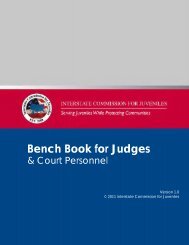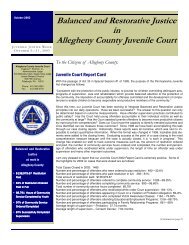News Summary News Summary - Pennsylvania Council of Chief ...
News Summary News Summary - Pennsylvania Council of Chief ...
News Summary News Summary - Pennsylvania Council of Chief ...
Create successful ePaper yourself
Turn your PDF publications into a flip-book with our unique Google optimized e-Paper software.
<strong>News</strong> <strong>Summary</strong><br />
January 22 – February 4, 2011<br />
Top Stories - National<br />
Whither Young Offenders? The Debate Has Begun<br />
The New York Times<br />
By TREY BUNDY, The Bay Citizen (CA)<br />
January 23, 2011<br />
http://www.nytimes.com/2011/01/23/us/23bcjuvenile.html<br />
Joaquin E. DiazDeLeon, a former Fresno gang member, spent two years inside California’s<br />
juvenile prison system. What he found there, he said, was no better than the streets he came from.<br />
Instead <strong>of</strong> rehabilitating young <strong>of</strong>fenders, he said, correctional <strong>of</strong>ficers spent most <strong>of</strong> their time<br />
separating rival gangs. Violence was so pervasive, he said, that he kept his gang affiliation just to<br />
protect himself.<br />
“Basically you’re being thrown in a box and expected to change,” said Mr. DiazDeLeon, 21, now a<br />
student at City College <strong>of</strong> San Francisco.<br />
Gov. Jerry Brown’s recent proposal to eliminate California’s Division <strong>of</strong> Juvenile Justice was billed<br />
as a way to cut $242 million from the state budget. It was also the culmination <strong>of</strong> a decade-long<br />
effort to shut the state’s troubled youth prison system, which for years has been plagued by<br />
violence, abuse and decaying facilities.<br />
Much <strong>of</strong> that effort has been centered in the Bay Area after accusations <strong>of</strong> abuse and neglect at<br />
the institutions surfaced in a 2003 Alameda County lawsuit. In recent years, some local judges<br />
<strong>of</strong>ten refused to send young <strong>of</strong>fenders to state institutions, preferring to confine them in county<br />
facilities regarded as safer and more effective.<br />
Mr. Brown’s initiative would take that un<strong>of</strong>ficial policy further. It would scrap the state juvenile<br />
justice system and shift responsibility for confining the most violent young <strong>of</strong>fenders to the local<br />
level, where they are nearer to family and have more community treatment options. The move<br />
would affect the 1,300 youths in state care, down from 10,000 in 1996.<br />
Even among critics <strong>of</strong> the Division <strong>of</strong> Juvenile Justice, the proposed shift has set <strong>of</strong>f a new debate<br />
over whether counties are equipped to handle an influx <strong>of</strong> severely troubled young people.<br />
“I’m disgusted with myself to think <strong>of</strong> defending D.J.J. with all the things that have happened over<br />
the years,” said Sue Burrell, a lawyer at the Youth Law Center in San Francisco, “but if you ask me<br />
right now, I would opt for keeping a very, very small D.J.J. open and not throwing the kids to the<br />
wolves.”<br />
Ms. Burrell said she was concerned that prosecutors might see counties as unfit to handle serious<br />
<strong>of</strong>fenders and thus try many juveniles as adults, forcing teenagers into adult prisons.<br />
Barry Krisberg, a senior fellow at the University <strong>of</strong> California, Berkeley, School <strong>of</strong> Law, said that<br />
keeping young <strong>of</strong>fenders at the county level might <strong>of</strong>fer them fewer rehabilitation options.<br />
40








